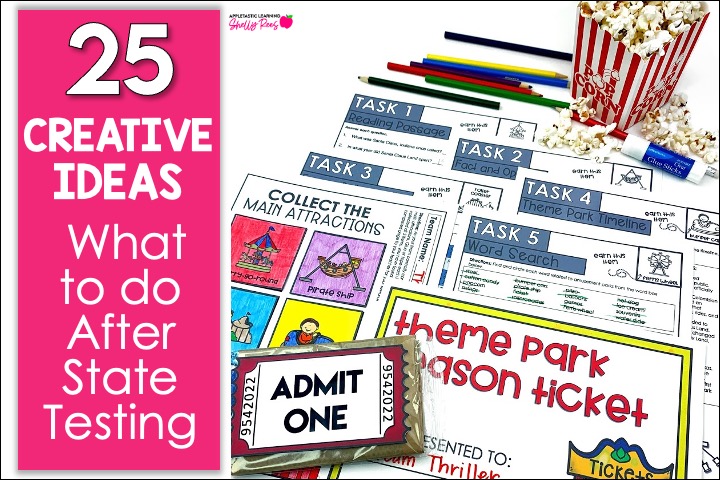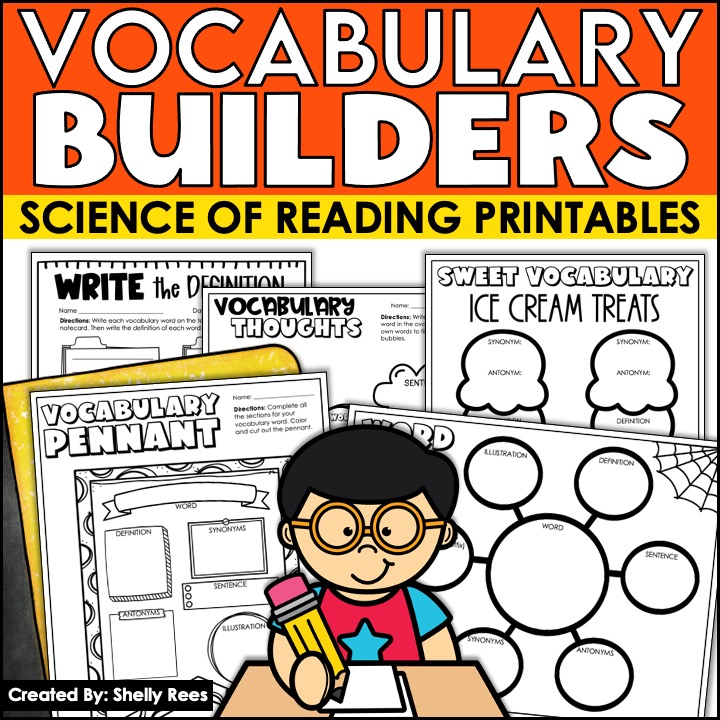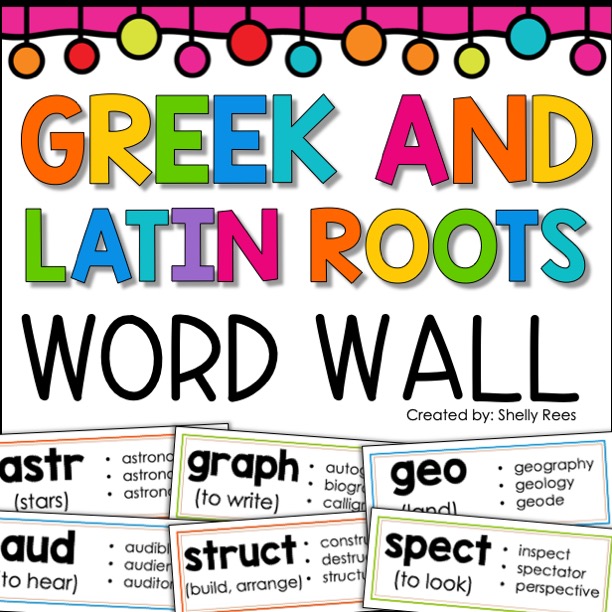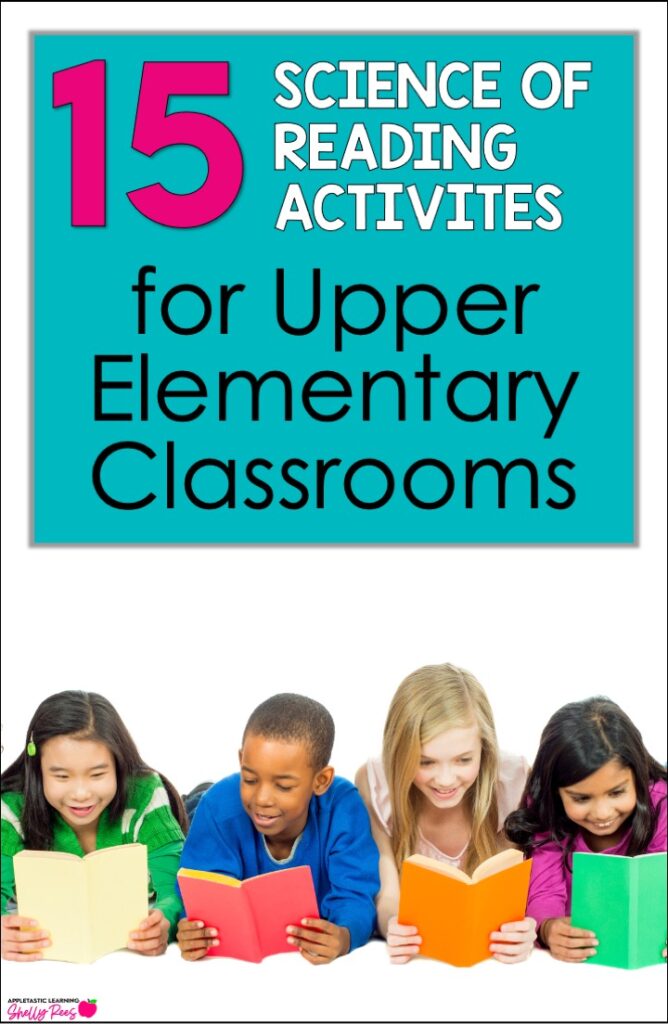

Science of reading activities can be so helpful for students of all ages. Reading is an essential skill to have in order to succeed in school and life. It’s not just about being able to read the words, it’s about understanding what you are reading and connecting those ideas with what you already know.
In this blog post, I will share some amazing science of reading activities that any teacher can use in the classroom. These activities are sure to engage your readers while helping them build important skills along the way! So let’s get started!
Just a quick note before we dive into these science of reading activities . . . each of these strategies supports at least one of the big 5 essential components of reading (phonemic awareness, phonics, reading fluency, comprehension, and vocabulary). Check out this blog post for more details on those components.
1. Word Squares
Word squares are a great way to help students learn new vocabulary words and increase their word recognition skills. In this activity, students must fill in a square grid with nine letters. They can either use the nine letters provided or come up with their own unique set of nine letters. Once they have created the grid, they must then find and fit words into the grid that meet certain criteria such as starting with specific letter combinations.
This exercise helps students become familiar with prefixes, suffixes, and root words which aids in improving their reading comprehension abilities. This one is a must-do in the world of science of reading strategies!
2. Word Jumbles
Word jumbles are another great way to help students stretch their reading muscles! A favorite among science of reading activities, word jumbles require students to unscramble a series of mixed-up letters to form meaningful words or phrases. Once they have identified the correct answer, they must then use those words in sentences or explain what the word means. This encourages deeper thinking about language and helps build important vocabulary skills.
3. Creative Writing Exercises
Creative writing exercises can help 3rd, 4th, and 5th graders practice their ability to express ideas through written language while also improving their understanding of grammar and sentence structure rules. These science of reading activities involve writing stories, poems, plays or other forms of literature based on given prompts or topics of interest determined by the teacher or student themselves. (Ready-to-go writing prompts are the perfect starting place for this strategy!)

Through these exercises, students can develop strong narrative skills that will transfer over into other areas of reading comprehension such as summarizing or analyzing texts more effectively.
4. Picture Book Analysis
Picture books provide an excellent resource for teaching literacy skills such as inference, visualization, theme development and more! In this activity, upper elementary readers are asked to analyze a picture book by looking at elements such as characters’ motivations, settings, plot development and other literary devices used by the author throughout the story’s progression.
After discussing their observations in small groups, they then write an essay that summarizes what they learned from their analysis of the picture book and how it relates to real life events or experiences.
5. Storytelling Circle
Storytelling circles provide a great opportunity for students to practice active listening skills while also deepening their understanding of stories’ themes and characters’ motivations through retellings from multiple perspectives!
During this activity, students sit in a circle where one person begins telling a story he/she has previously read aloud from beginning to end without interruptions from others in the group until reaching its conclusion point; at which time another person starts telling his/her version of the same story but adding some personal spin before passing it along again until everyone has had an opportunity to tell part(s) of it! This exercise encourages better engagement with text and a deeper level of comprehension.
6. Reading Board Games
Reading board games are a fun and interactive way to help 3rd, 4th, and 5th graders practice and refine their ELA skills! To play, get out a set of reading task cards and any board game. Use the reading task cards as game play cards. Every time a student gets an answer right, he or she can advance on the game board or take a turn rolling the dice, moving a checkers piece or advancing a token.

Playing these types of games encourages critical thinking by requiring players to recall information from the text as well as make inferences to come up with accurate answers quickly.
7. Main Idea Bingo
Main Idea Bingo is an excellent way to reinforce the concept of summarizing while also improving reading comprehension skills at the same time. To play this game, each student is given a bingo card filled with words (or phrases) related to a particular topic that they must then find within a given text or passage. Whoever identifies the most words in relation to the main idea first wins!
This exercise provides students with an opportunity to pick out key information from longer pieces of writing which will help them become better readers in general.
8. Alternative Book Reports
Book reports don’t have to be boring, but they surely can be beneficial to increasing engagement with a specific book or story! Increase comprehension and understanding of main idea, characters, theme, etc., with a fun, hands-on book report, such as this FREE Book Report Lapbook! This is a favorite of students and teachers alike! Did we mention that it’s free?
9. Vocabulary Map Exercises
Vocabulary map exercises are yet another science of reading activity that helps upper elementary learners learn about and study new vocabulary words! During this activity, students use graphic organizers like webs, double bubble maps, Venn diagrams etc., depending on what type of vocabulary terms they are trying to learn.

This helps students gain deeper insights into how language works so that they can use new vocabulary correctly when communicating orally or through writing later on down the line! Vocabulary maps are great science of reading activities!
10. Word Walls
Word walls have become increasingly popular among teachers looking for creative ways to get their 3rd, 4th, and 5th graders engaged in language acquisition processes! This strategy involves displaying words across multiple surfaces throughout classrooms such as bulletin boards, chalkboards etc., so that students can easily reference them throughout lessons whenever needed. This allows for greater exposure and usage opportunities when it comes time for assessments later on in school year.
11. Summarizing Strategies
These Science of Reading strategies are a great way for older students to learn how to make sense of longer pieces of writing by condensing them into shorter, more concise versions. To do this, they must first identify main ideas and supporting details within a given text before selecting the most important parts of it. Then, students can use these elements to compose their own summaries that can be shared with the class!
Doing this exercise regularly will help students develop better comprehension skills as well as critical thinking abilities.
12. “Find Someone Who”
“Find Someone Who” is an interactive way to practice language skills while also having fun at the same time! This exercise works by giving each student in a class a list of questions related to a particular topic or subject area (i.e., grammar rules, vocabulary terms etc.) that they must then answer by finding someone in the room who knows the answer. Whoever finds all of their answers first wins!
This game is one of my favorite science of reading activities! It encourages active engagement with material while also helping build social skills like communication and cooperation among peers too.
13. Word Study
Word study is an excellent strategy for helping upper elementary students become more independent readers and writers in general! To do so, teachers typically provide targeted instruction on specific word patterns or rules that are designed to make understanding new words easier (i.e., phonics, morphological analysis, roots etc.). Then, through regular practice exercises such as creating sentences using certain vocabulary terms etc., students can put what was learned into action so that it eventually becomes second nature when it comes time for assessments later on down the road!
This Greek and Latin Roots Word Wall is perfect for word study!

14. Read Alouds
Read alouds are an effective activity for improving comprehension development among 3rd, 4th, and 5th grade learners since they allow students to listen and interact with stories being read out loud! During these Science of Reading activities, teachers typically provide contextual clues about characters/settings before reading passages out loud which helps cultivate curiosity around what’s next!
Afterwards, open-ended discussion questions and other reflective tasks encourage active engagement with material which ultimately leads to deeper understanding of content overall. This makes read alouds an excellent tool for developing comprehension for all levels of learners!
15. Text Talk
Text Talk is another favorite among science of reading activities for older students; one that encourages collaboration and higher-level thinking at the same time! This exercise works by dividing students into small groups. Learners are given short pieces of writing (i.e., articles, poems etc.) before being asked various questions about it such as characters, main idea, or theme connections.
Asking these types of questions encourages deep thinking about topics covered within text while also promoting problem-solving skills too!
So there you have it, a list of 15 science of reading activities that are super helpful in the upper elementary grades! Each one is designed to foster comprehension development as well as critical thinking abilities which are invaluable tools in any student’s academic toolkit.
Whether you’re looking to increase retention rates or just want your kids to enjoy learning more, these science of reading activities should help get the job done!


Hi, I’m Shelly! Thank you for being here. I love helping third, fourth, and fifth grade teachers with fun and engaging activities that require no to little prep! Let me help you by taking some of the stress and work off your plate.

©2022 Shelly Rees. All Rights Reserved.